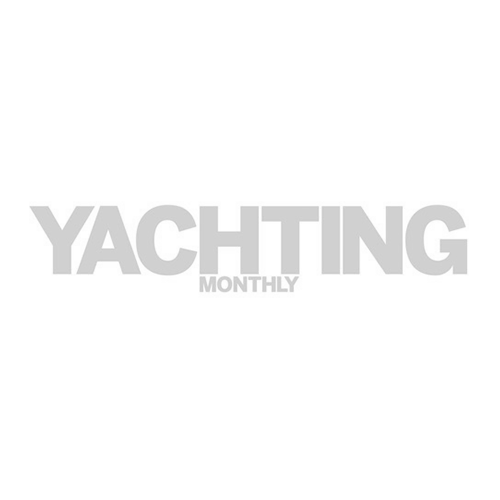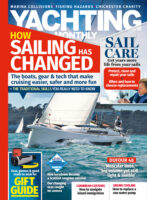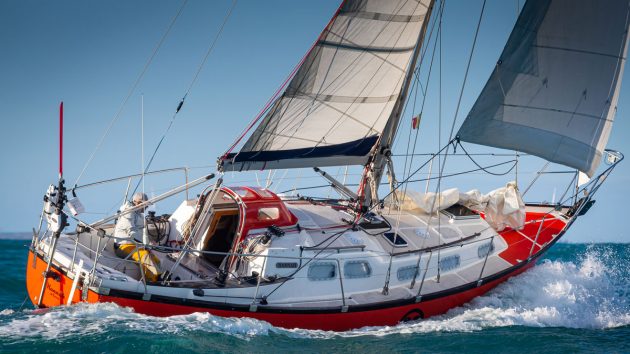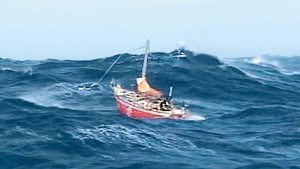
Golden Globe Race 2022 entrant Guido Cantini aboard Hannah of Cowes the Vancouver 34. Credit: Guido Cantini/Hannah Racing.
The Golden Globe Race revival is setting off again in 2026 for its third edition.
The event, an ode to the ‘golden age’ of adventurous sailing, was relaunched in 2018 to mark the 50th anniversary of the iconic Sunday Times Golden Globe Race. It remains an enduring test of tenacity, endurance, and technical skill.
Origins of the Golden Globe Race
The Sunday Times Golden Globe Race is the stuff of legends, and has inspired generations of sea men.
It yielded sailing heroes like Sir Robin Knox Johnston and Bernard Moitessier, as well as more tragic figures like Donald Crowhurst and Nigel Tetley, and led to the founding of events such as Sir Chay Blyth‘s Global Challenge, the BOC Challenge, later the Velux 5 Oceans Race, and even the Vendée Globe, now the high-tech pinnacle of single-handed non-stop circumnavigation.
After Sir Francis Chichester‘s historic 1966-67 solo round-the-world sail, which included one stop in Sydney, the race was on to see who would be the first to do it non-stop.
As multiple sailors planned a continuous voyage, The Sunday Times opted to bring their individual adventures together under the umbrella of a shared event.
Of the nine sailors that entered, only one finished. One kept sailing, one tragically lost his life (and likely his mind) at sea, and another was found dead just a few years after the event’s end.
In 2018, on the 50th anniversary of the original Golden Globe Race, Don McIntyre‘s McIntyre Ventures re-launched the Golden Globe Race in its original format, attempting to preserve much of its original spirit.
What is the Golden Globe Race like now?
Like the Sunday Times Golden Globe Race, the “new” Golden Globe Race is a nonstop, single-handed, unassisted, east-about (from the west towards the east, so clock-wise) sail around the world.
That’s one (potentially amateur) sailor, on one (vintage) boat, in near-total communion with their environment, facing the world’s oceans in all their awesome glory, for the better part of a year.
Pretty insane, right?
It’s not for nothing that the GGR has been called ‘the Voyage of Madmen’ and the ‘Loneliest Race in the World,’ and inspired countless books, documentaries, and other media.
What are the rules?
In the 2026 Golden Globe Race, entrants are ‘sailing like it’s 1968,’ with only the technology Sir Robin Knox-Johnston would’ve had onboard Suhaili.
That means no satellite-based navigation aids, no electronic instruments, autopilots, computers, cell phones, iPads, etc allowed. The regulations also prohibit the use of synthetic materials like Spectra, Kevlar or Vectron.
Instead, entrants sail by sextant, using paper charts, keeping a log and reading the weather themselves.
Can entrants speak to the outside world?
GGR entrants can communicate only by long-range, high frequency radio (though they are fully equipped with a satellite phone, a sealed electronic GPS, and other emergency measures).
Via the radio, they can speak to media, family, friends, and sponsors. They can receive weather reports, but no form routing advice. Radio conversations containing navigation advice to/from other competitors and other vessels at sea are also permitted, though any exchange of supplies or parts, which would count as ‘assistance,’ is not.
What happens if you break the rules?
Entrants who break these rules can continue taking part in the race, even if they are no longer eligible for the trophy.
Sailors who make one stop or access their emergency electronic equipment can keep sailing under the Chichester class, while anyone who does not depart on the start date can compete under the Carozzo Class, named for Alex Carozzo, who departed for the 1968 Golden Globe on time to fulfill the race conditions and then proceeded to sit on a mooring for another week to finish preparations.
Where does the Golden Globe Race 2026 start, and how long does it take?
The 2026 edition is leaving on 6 September 2026 from Les Sables d’Olonne.
Their 30,000 mile voyage takes around 250 days, with the fastest time being just under 212 (achieved by Jean-Luc Van Den Heede, Vendée Globe alum and winner of the 2018 edition) and slower entries reaching up to 300 days. The winner of the 2022 edition, Kirsten Neuschäfer, did it in 233.
Still, with many a self-steering wind-vane failure, dismasting, and potentially life-threatening situation, it’s considered a success to finish the race all.
What’s the route?
On their east-about track, entrants stop for a ‘film drop’ (or ‘Photo Gate’) in the Canary Islands before sailing through the South Atlantic. They cross another Photo Gate in Cape Town.
After passing the Cape of Good Hope, they head into the Indian Ocean, pass Australia keeping Cape Leeuwin to port, and hit another Photo Gate in Hobart, Australia.
From there, they take on the infamous Southern Ocean, subject of fear and fascination alike. Rounding Cape Horn, they sail up through the Atlantic to arrive back to Les Sables d’Olonne and complete their circumnavigation.
Arrivals for the 2026/27 edition are foreseen between April and June 2027.
What kind of boats are allowed?
The Notice of Race has clear specifications for the vessels allowed in the race. These are designed to maximise safety for entrants, as well as to preserve the spirit of the original event.
Yachts must:
- Be production boats between 32 and 36ft overall, designed before 1988, with a minimum of 20 models made from the same mould
- Have fibre-reinforced plastic construction
- Have a full length keel with a rudder attached to their trailing edge
- Have minimum design displacement of 6,200kg
- Have undergone meticulous refit and survey in preparation
Both the rig, deck, and interiors must be as close as possible to the boat’s original design, so as not to encourage expensive yacht modifications that might give an entrant an unfair advantage.
In the 2026 edition, no more than 7 boats of the same design are allowed within the same race.
Favoured models with the 2026 cohort include the Rustler 36, the Biscay 36, the Olle Enderlein 32, the Cape George 36, and the Saltram Saga 36. Some boats have been refit and prepared for previous editions of the race.
Who can enter the Golden Globe Race?
Skipper requirements
Unlike the 1968 Golden Globe Race, which had no specific qualification requirements (Sir Charles Blyth was a novice, though he had previous rowing experience!), no consistent identified starting point, and no official start date beyond requiring skippers to leave the Northern Hemisphere between 1 June and 31 October 1968, the updated Golden Globe Format has some minimum experience requirements to guarantee a baseline of safety.
Skippers need to have logged at least 4,000 nautical miles of ocean sailing, either solo or crewed, before applying for invitation to enter. Their tally needs to have reached 8,000 by the time they submit their Pre-Registration pack.
By the time of Registration, they need to have another 2,000 nautical miles of solo sailing, and then 4,000 more (solo, non-stop) on the yacht they intend to enter in the Golden Globe race within 18 months of the race’s start.
These tallies are modified for entrants who have previously qualified, and there are some additional requirements with licenses and safety certificates, which you can find in the Notice of Race.
Who is this race for?
In short, anyone who wants to do it.
In founder Don McIntyre’s words, this race is designed for ‘the little guy.’
While he appreciates the high level of skill and technological advancements ocean racing has featured in the past decades, ‘The problem is that it’s very expensive, and not everyone can make it to the Olympics. That means that for the last thirty years, any sailor anywhere in the world who ever wanted to race around the world hasn’t had an opportunity.’
This event is designed to be ‘something that the average sailing person worldwide (with commitment) can compete in,’ and to resist the ever-growing role of sponsorship in racing. Many GGR entrants are not actually career racers, but regular (seafaring) people.
Entrants for 2026:
Provisional entries list:
Entrants who competed in previous editions are marked with an asterisk.
Mike Smith* (Australia)
Edward Walentynowicz* (Canada)
Isa Rosli (Candada)
Damien Guillou* (France)
Louis Kerdelhué (France)
Arsène Ledertheil (France)
Oleg Schmidt (Germany)
Pat Lawless* (Ireland)
Guido Cantini (Italy)
Andrea Lodolo (Italy)
Mara Løvenskiold Kveseth (Norway)
Daniel Alfredsson (Norway)
Pär Nyman (Sweden)
Etienne Messikommer (Switzerland)
Selim Yalcin (Turkey)
Andrew Ritchie (UK)
Henry Wootton (UK)
Matt Woodside (USA)
Olivia Wyatt (USA)
Erden Eruç (USA)
Stephen Wraith (USA)
Gunnar Christensen (USA)
Colm Walker (USA)
Larry Schmid (USA)
Christopher Langham (USA)
… and one mysterious confidential entry– we can’t help but wonder whether it might be Don McIntyre himself!
Leaderboards from previous editions:
2022-2023
- Kirsten Neuschäfer – SOUTH AFRICA – Cape George Cutter, CG36
- Abhilash Tomy – INDIA – Rustler 36 Masthead Sloop
- Michael Guggenberger – AUSTRIA – Biscay 36 Masthead Ketch
2018
- Jean-Luc Van De Heede – FRANCE – Rustler 36 Masthead Sloop
- Mark Slats – DENMARK – Rustler 36 Masthead Sloop
- Uku Randmaa – ESTONIA – Rustler 36 Masthead Sloop
Other races from McIntyre Adventures
As Founder and CEO of McIntyre Adventures, McIntyre has already ideated two other events that take sailing back to a simpler, not-too-distant time: the Mini Globe Race and the Ocean Globe Race.
The Mini Globe Race celebrates the small-boat spirit within the world of adventure-style, around the world racing. The Ocean Globe Race is instead in the spirit of the 1973 Whitbread Round the World Race, the first ever fully-crewed around the world race.
‘Why are we doing it?’ McIntyre says of reviving this style of racing. ‘It’s bringing it back to the people.’














